A Field Guide to Harvest Equipment
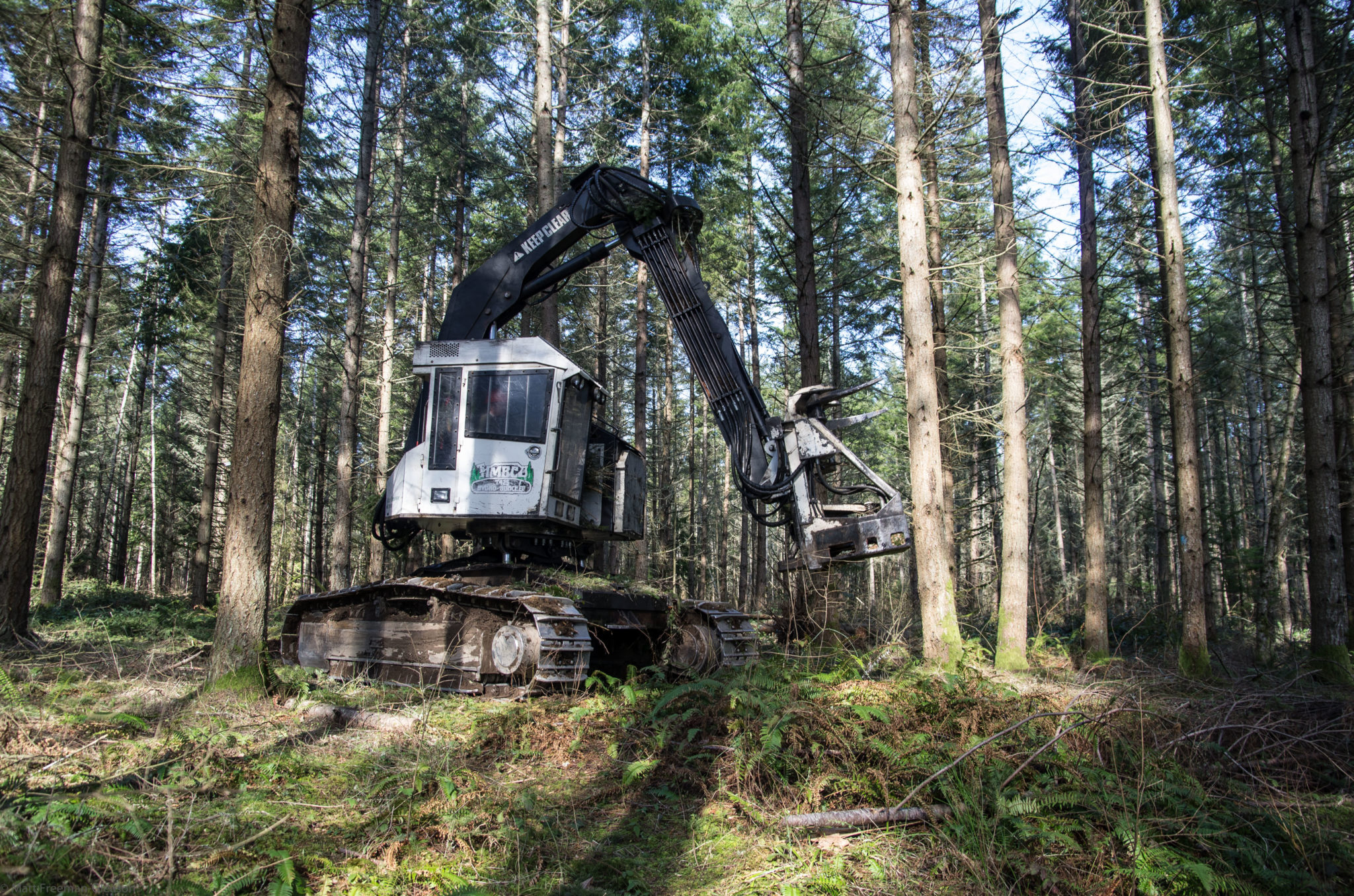
Updated Oct 6, 2021
The forests of the Pacific Northwest are teeming with movement and noise—not all of it animal in origin! Stroll through an NNRG member forest undergoing an ecological harvest or thinning and you might catch a glimpse of one of these logging machines (don’t forget to wear appropriate safety-gear!).
The forests of the Pacific Northwest are teeming with movement and noise—not all of it animal in origin! Stroll through an NNRG member forest undergoing an ecological harvest or thinning and you might catch a glimpse of one of these logging machines (don’t forget to wear appropriate safety-gear!).
FELLER-BUNCHER
IDENTIFYING MARKS: An operator cab on wheels or tracks with a tree-grabbing hydraulic arm furnished with a chain-saw, circular saw or a shear.
DIET: Uncut trees
FEEDING BEHAVIOR: Arm with felling head attachment reaches toward a single tree or group of trees and holds the tree stem(s) with small grappling arms while a sawblade attached to the head cuts the stem or stems.
FOUND IN: Most forests where pre-commercial or commercial harvests are happening. Tracked feller-bunchers can operate on slopes up to 50%. Wheeled feller-bunchers can operate on slopes up to 25%
MORE INFO: U.S. Forest Service
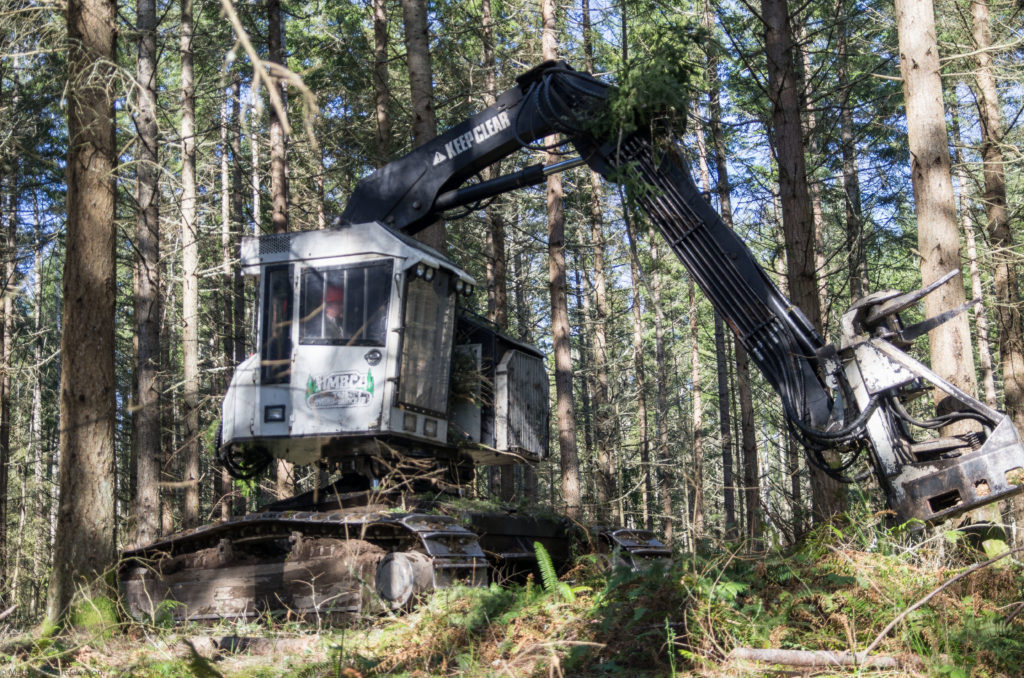
Feller-Buncher
IDENTIFYING MARKS: An operator cab on wheels or tracks with a tree-grabbing hydraulic arm furnished with a chain-saw, circular saw or a shear.
DIET: Uncut trees
FEEDING BEHAVIOR: Arm with felling head attachment reaches toward a single tree or group of trees and holds the tree stem(s) with small grappling arms while a sawblade attached to the head cuts the stem or stems.
FOUND IN: Most forests where pre-commercial or commercial harvests are happening. Tracked feller-bunchers can operate on slopes up to 50%. Wheeled feller-bunchers can operate on slopes up to 25%
MORE INFO: U.S. Forest Service

PROCESSOR
IDENTIFYING MARKS: A wheeled or tracked machine with a cab and processing head attached to an articulated arm. Cabs are capable of rotating.
DIET: Cut or uncut trees with the limbs still on. Prefers single stem species such as Douglas-fir, hemlock, and alder.
FEEDING BEHAVIOR: Delimbs and bucks a single stem into multiple logs (commonly referred to as a “cut to length” system). First either grabs and cuts a tree at the base, or lifts a cut stem, then feeds the stem through the cutting head using feed rollers. Delimbing knives shear branches from the stem as it moves through the head. A bar saw cuts the stem to specified lengths.
FOUND IN: Although usually found in close proximity to a feller buncher; on most pre-commercial and commercial harvest sites, it can be found working individually to cut, limb and buck trees to length in the woods.
MORE INFO: OSHA Logging E-Tool
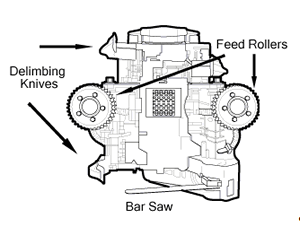
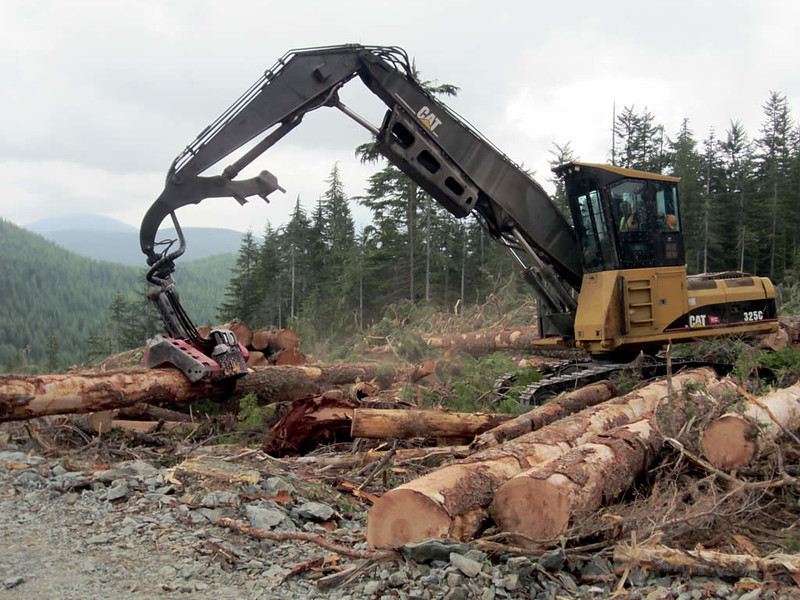
Processor
IDENTIFYING MARKS: A wheeled or tracked machine with a cab and processing head attached to an articulated arm. Cabs are capable of rotating.
DIET: Cut or uncut trees with the limbs still on. Prefers single stem species such as Douglas-fir, hemlock, and alder.
FEEDING BEHAVIOR: Delimbs and bucks a single stem into multiple logs (commonly referred to as a “cut to length” system). First either grabs and cuts a tree at the base, or lifts a cut stem, then feeds the stem through the cutting head using feed rollers. Delimbing knives shear branches from the stem as it moves through the head. A bar saw cuts the stem to specified lengths.
FOUND IN: Although usually found in close proximity to a feller buncher; on most pre-commercial and commercial harvest sites, it can be found working individually to cut, limb and buck trees to length in the woods.
MORE INFO: OSHA Logging E-Tool


FORWARDER
IDENTIFYING MARKS: An operator’s cab and a log ‘bunk’ that carries logs away from a site. Basically a tractor with up to eight wheels pulling a wagon load of wood. Often found with a boom mounted grapple for loading and unloading material. Sometimes found with tracks that slide over wheels. Some operator’s cabs rotate.
DIET: Processed logs.
FEEDING BEHAVIOR: An arm with a grappling hook grabs processed logs where they’ve been piled by a processor in the woods, then delivers to a log landing or loads directly onto a log truck.
FOUND IN: Usually in close proximity to a processor, or “cut-to-length” system. Works well where multiple products are being produced in the woods, as they are capable of sorting and extracting material by product.
MORE INFO: U.S. Forest Service
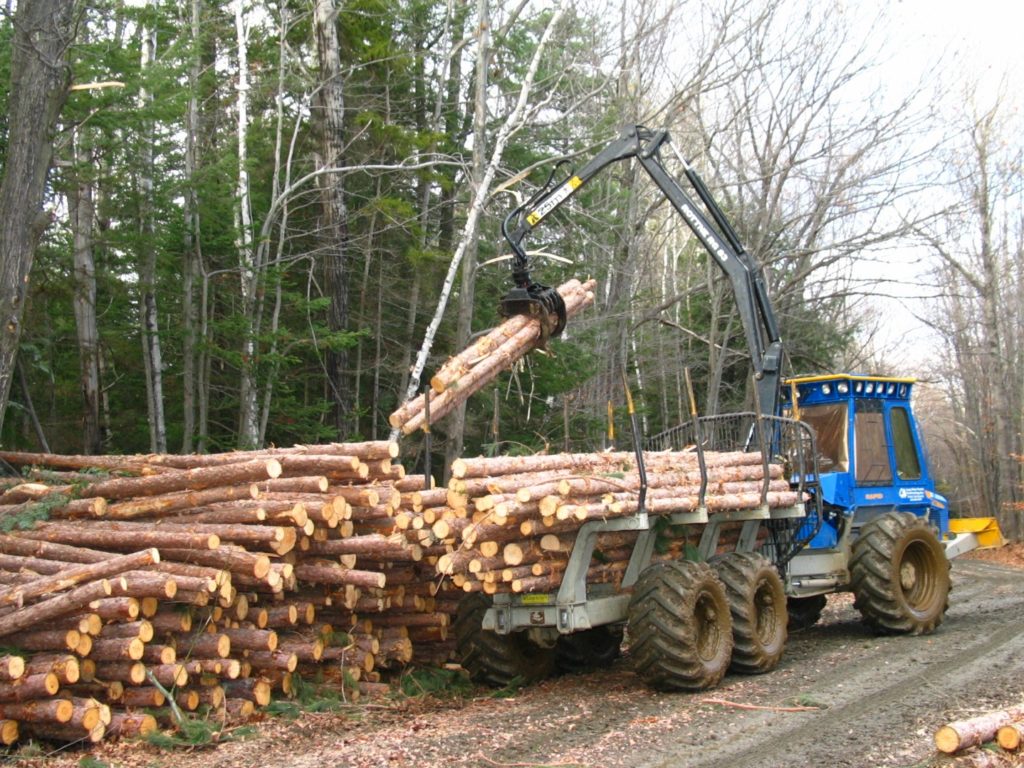
Forwarder
IDENTIFYING MARKS: An operator’s cab and a log ‘bunk’ that carries logs away from a site. Basically a tractor with up to eight wheels pulling a wagon load of wood. Often found with a boom mounted grapple for loading and unloading material. Sometimes found with tracks that slide over wheels. Some operator’s cabs rotate.
DIET: Processed logs.
FEEDING BEHAVIOR: An arm with a grappling hook grabs processed logs where they’ve been piled by a processor in the woods, then delivers to a log landing or loads directly onto a log truck.
FOUND IN: Usually in close proximity to a processor, or “cut-to-length” system. Works well where multiple products are being produced in the woods, as they are capable of sorting and extracting material by product.
MORE INFO: U.S. Forest Service

LOG LOADER (SHOVEL)
IDENTIFYING MARKS: An operator’s cab on a wheeled, tracked, or trailer-mounted base. Typically has a swinging hydraulic boom with a modified excavator, or ‘shovel’ mounted on the end.
DIET: Processed logs
FEEDING BEHAVIOR: Moves logs from forest to a landing by picking up logs with the grapple and swinging them around to drop them closer to the landing. Also used to move and sort logs from a stacked pile at the landing onto a log truck.
FOUND IN: Clear cuts, areas where the harvest is taking place close to a road, or where soil disturbance should be limited.
MORE INFO: U.S. Forest Service
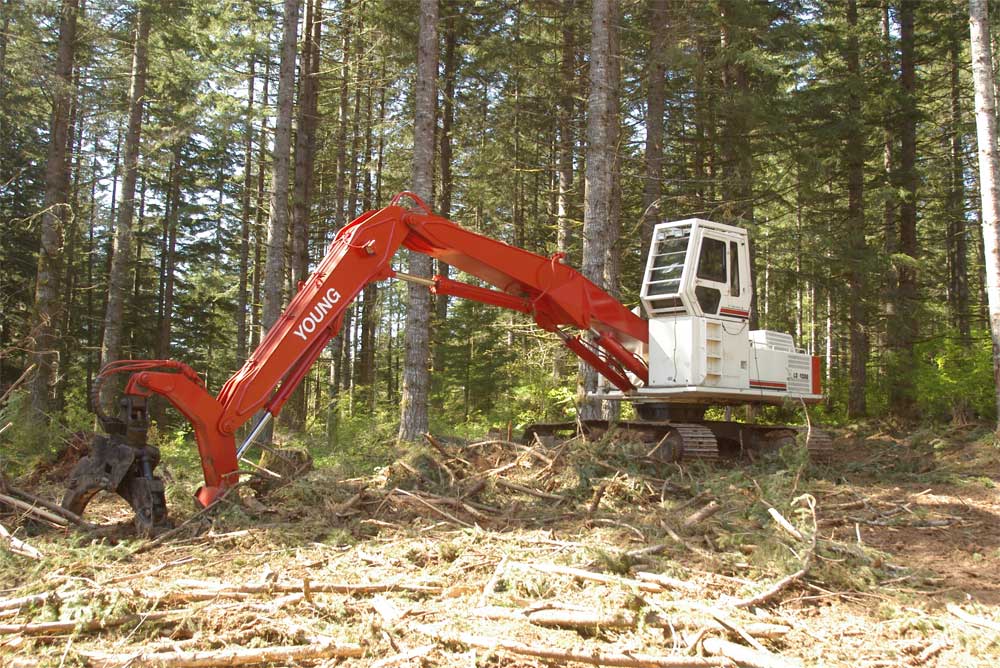
Log loader (Shovel)
IDENTIFYING MARKS: An operator’s cab on a wheeled, tracked, or trailer-mounted base. Typically has a swinging hydraulic boom with a modified excavator, or ‘shovel’ mounted on the end.
DIET: Processed logs
FEEDING BEHAVIOR: Moves logs from forest to a landing by picking up logs with the grapple and swinging them around to drop them closer to the landing. Also used to move and sort logs from a stacked pile at the landing onto a log truck.
FOUND IN: Clear cuts, areas where the harvest is taking place close to a road, or where soil disturbance should be limited.
MORE INFO: U.S. Forest Service

SKIDDER (RUBBER-TIRED)
IDENTIFYING MARKS: A four-wheeled chassis with an operator’s cab mounted in the front and a cable drum and/or grapple with extending arm mounted on the rear. Some may have a shovel for grading mounted at the front.
DIET: Processed logs or whole trees with limbs and tops.
FEEDING BEHAVIOR: Lifts the front ends of the logs or trees from the ground with grapple or choker cable, drags them from the woods to a landing or roadside.
FOUND IN: Harvests taking place too far from the road to make use of a log loader, where the extraction distances are up to 1000 feet.
MORE INFO: U.S. Forest Service
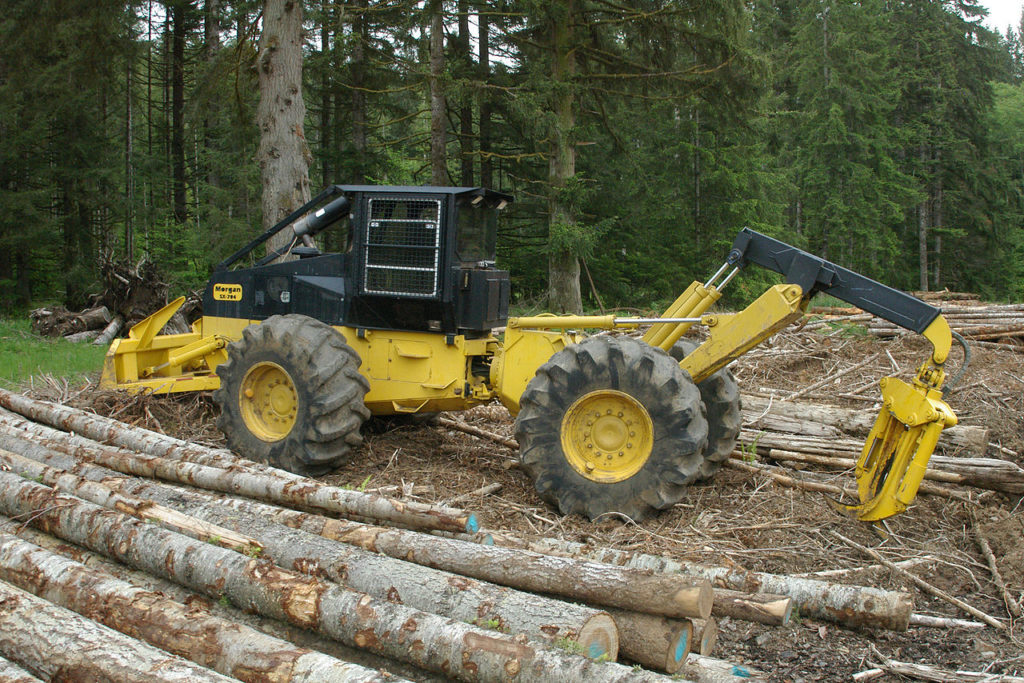
Skidder (rubber-tired)
IDENTIFYING MARKS: A four-wheeled chassis with an operator’s cab mounted in the front and a cable drum and/or grapple with extending arm mounted on the rear. Some may have a shovel for grading mounted at the front.
DIET: Processed logs or whole trees with limbs and tops.
FEEDING BEHAVIOR: Lifts the front ends of the logs or trees from the ground with grapple or choker cable, drags them from the woods to a landing or roadside.
FOUND IN: Harvests taking place too far from the road to make use of a log loader, where the extraction distances are up to 1000 feet.
MORE INFO: U.S. Forest Service

TRACKED SKIDDER (CAT)
IDENTIFYING MARKS: A track mounted chassis with a boom-mounted grapple or cable drum mounted to one end and a shovel attachment on the other. Often called a ‘cat’.
DIET: Processed logs or whole trees with limbs and tops.
FEEDING HABITS: Use a grapple or cable(s) to “skid”, or drag, trees from the felling site to a landing or road. The shovel attachment is used to clear logging material. Sometimes used to redistribute or scatter logging slash back into the woods and on skid trails.
FOUND IN: Pre-commercial or commercial harvests where logged material is farther from the road, or where slopes are too steep for a wheeled skidder. Also common on softer, or wetter, soils as tracked skidders don’t cause ruts or as much soil disturbance as wheeled skidders.
MORE INFO: U.S. Forest Service
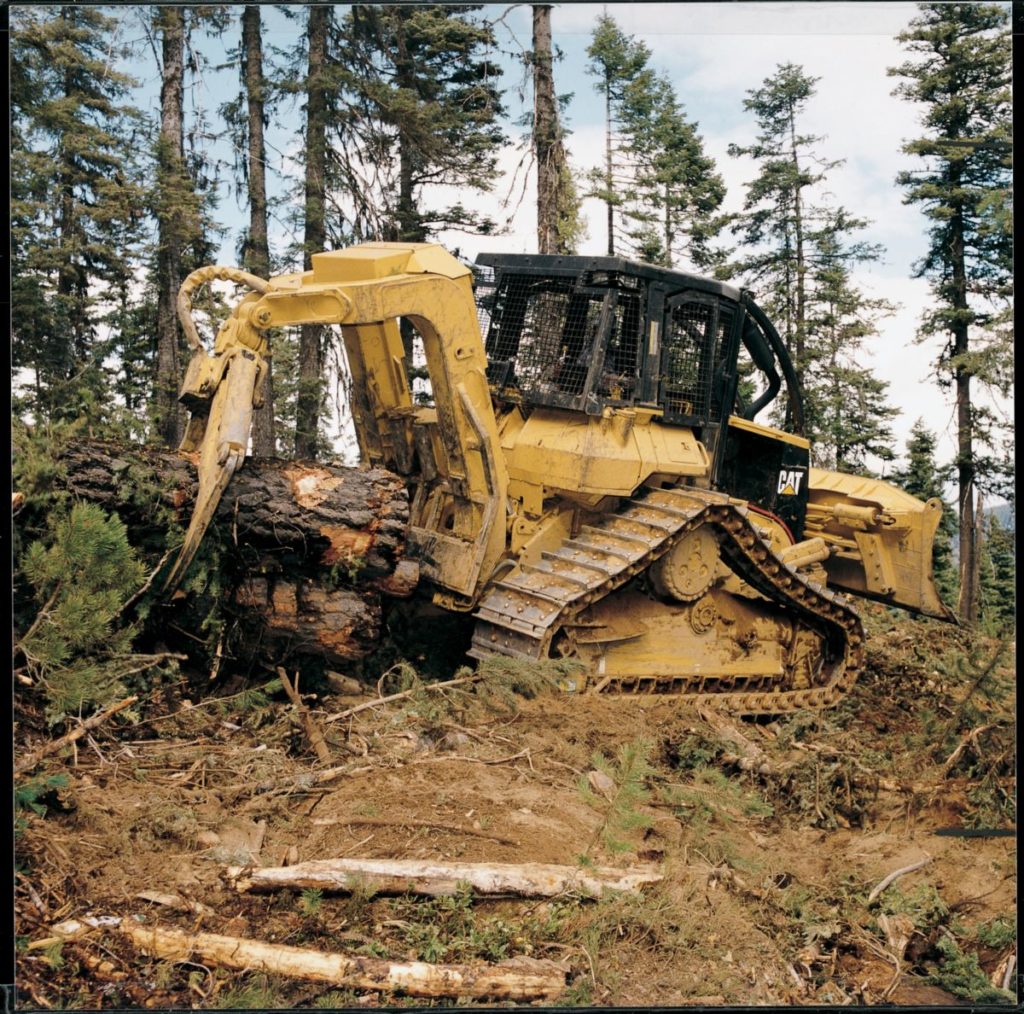
Tracked skidder (Cat)
IDENTIFYING MARKS: A track mounted chassis with a boom-mounted grapple or cable drum mounted to one end and a shovel attachment on the other. Often called a ‘cat’.
DIET: Processed logs or whole trees with limbs and tops.
FEEDING HABITS: Use a grapple or cable(s) to “skid”, or drag, trees from the felling site to a landing or road. The shovel attachment is used to clear logging material. Sometimes used to redistribute or scatter logging slash back into the woods and on skid trails.
FOUND IN: Pre-commercial or commercial harvests where logged material is farther from the road, or where slopes are too steep for a wheeled skidder. Also common on softer, or wetter, soils as tracked skidders don’t cause ruts or as much soil disturbance as wheeled skidders.
MORE INFO: U.S. Forest Service

EXCAVATOR
IDENTIFYING MARKS: A track mounted chassis with a boom-mounted excavator (shovel).
DIET: Dirt, brush, harvest debris.
FEEDING HABITS: Uses shovel head to push and pick up dirt, slash, and other logging material.
FOUND IN: Sites where road work and/or slash treatments are required.
MORE INFO: U.S. Forest Service
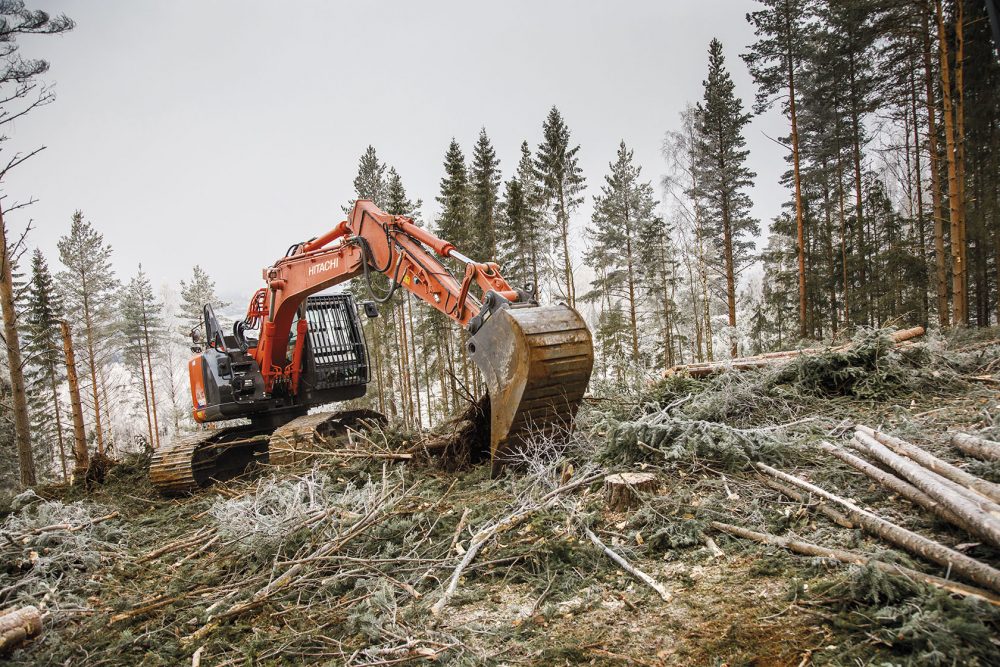
Excavator
IDENTIFYING MARKS: A track mounted chassis with a boom-mounted excavator (shovel).
DIET: Dirt, brush, harvest debris.
FEEDING HABITS: Uses shovel head to push and pick up dirt, slash, and other logging material.
FOUND IN: Sites where road work and/or slash treatments are required.
MORE INFO: U.S. Forest Service

BRUSH-RAKE PILING CAT
IDENTIFYING MARKS: A four-wheeled or track-mounted chassis with an operator’s cab and large, forward-facing “rake” attachment on the front.
DIET: Brush and logging slash.
FEEDING HABITS: Pushes logging slash and other material out of the way or into piles.
FOUND IN: Commercial harvests and clearcuts where brush or logging slash is excessive and needs to be cleared for replanting.
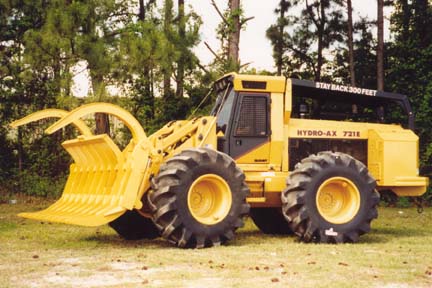
Brush-rake piling cat
IDENTIFYING MARKS: A four-wheeled or track-mounted chassis with an operator’s cab and large, forward-facing “rake” attachment on the front.
DIET: Brush and logging slash.
FEEDING HABITS: Pushes logging slash and other material out of the way or into piles.
FOUND IN: Commercial harvests and clearcuts where brush or logging slash is excessive and needs to be cleared for replanting.

TOWER YARDER
IDENTIFYING MARKS: A four-wheeled or track-mounted chassis with an operator’s cab and tall vertical fixed tower with cable drums at the end of it.
DIET: Cut logs
FEEDING HABITS: Uses cables attached to the top of the tower to pull logs from a steep sloped toward a landing near the yarder; alternatively uses cables to lift logs in the air and pull them along a suspended cable with a pulley toward a landing near the yarder.
FOUND IN: Harvests happening on steeper slopes (>50%) that is inaccessible to standard ground-based logging equipment..
MORE INFO: U.S. Forest Service
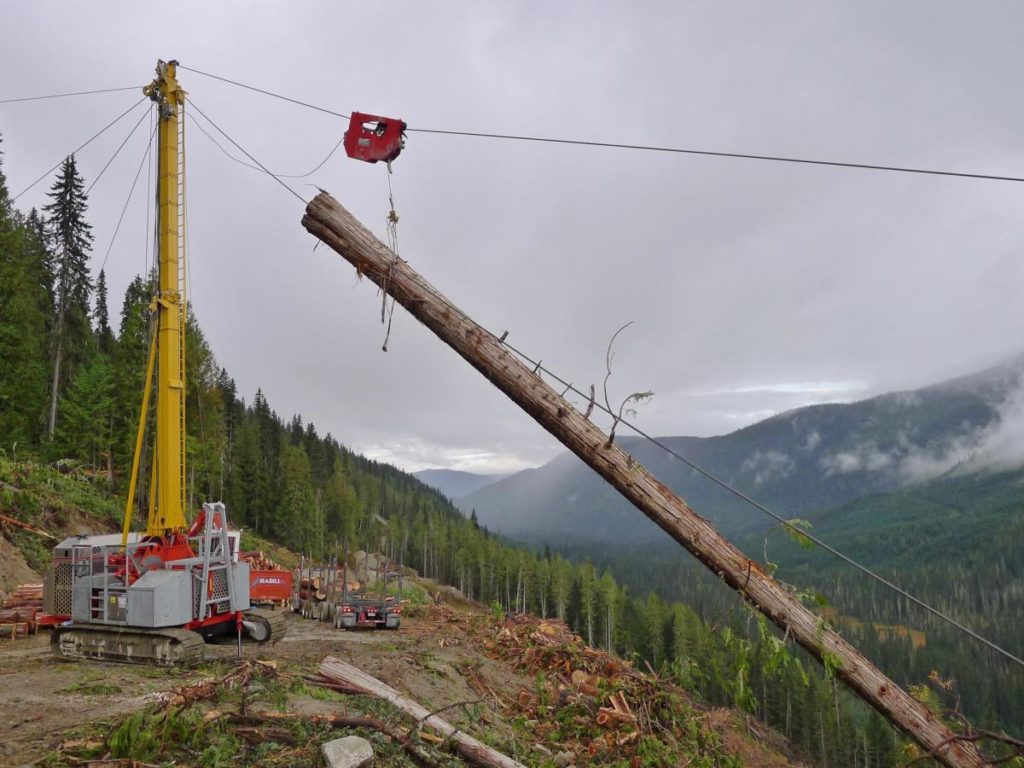
Tower yarder
IDENTIFYING MARKS: A four-wheeled or track-mounted chassis with an operator’s cab and tall vertical fixed tower with cable drums at the end of it.
DIET: Cut logs
FEEDING HABITS: Uses cables attached to the top of the tower to pull logs from a steep sloped toward a landing near the yarder; alternatively uses cables to lift logs in the air and pull them along a suspended cable with a pulley toward a landing near the yarder.
FOUND IN: Harvests happening on steeper slopes (>50%) that is inaccessible to standard ground-based logging equipment..
MORE INFO: U.S. Forest Service

YODER
IDENTIFYING MARKS: A cross between a yarder and a loader. An articulated hydraulic arm mounted to a wheeled or tracked chassis with a cable system attachment.
DIET: Cut logs
FEEDING HABITS: Uses cable system to pull logs from the felling site to a landing. Often found pulling logs shorter distances and in smaller areas than can be accessed by the tower yarder.
FOUND IN: Harvests happening on steeper slopes (>50%) that is inaccessible to standard ground-based logging equipment.
MORE INFO: U.S. Forest Service

Yoder
IDENTIFYING MARKS: A cross between a yarder and a loader. An articulated hydraulic arm mounted to a wheeled or tracked chassis with a cable system attachment.
DIET: Cut logs
FEEDING HABITS: Uses cable system to pull logs from the felling site to a landing. Often found pulling logs shorter distances and in smaller areas than can be accessed by the tower yarder.
FOUND IN: Harvests happening on steeper slopes (>50%) that is inaccessible to standard ground-based logging equipment.
MORE INFO: U.S. Forest Service


Leave a Reply